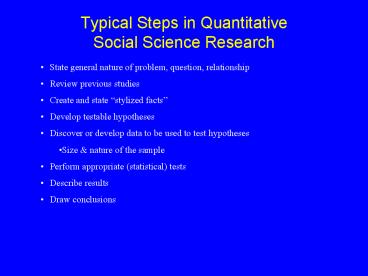Typical Steps in Quantitative Social Science Research - PowerPoint PPT Presentation
Title:
Typical Steps in Quantitative Social Science Research
Description:
Econometric model of effect of Internet use on scholarly productivity ... Traditional Bibliometric Model of Scholarly Productivity ... – PowerPoint PPT presentation
Number of Views:44
Avg rating:3.0/5.0
Title: Typical Steps in Quantitative Social Science Research
1
Typical Steps in Quantitative Social Science
Research
- State general nature of problem, question,
relationship - Review previous studies
- Create and state stylized facts
- Develop testable hypotheses
- Discover or develop data to be used to test
hypotheses - Size nature of the sample
- Perform appropriate (statistical) tests
- Describe results
- Draw conclusions
2
Two examples with two very different models
- Econometric model of effect of Internet use on
scholarly productivity - Financial model to estimate costs of removing
minority preferences in broadcast licensing
3
Traditional Bibliometric Model of Scholarly
Productivity
Socio-economic factors
Institutional factors
Funding
Research output
Citation Noam Kaminer, Yale M. Braunstein
"Bibliometric Analysis of the Impact of Internet
Use on Scholarly Productivity." JASIS 49(8)
720-732 (1998)
4
Revised Bibliometric Model of Scholarly
Productivity
Socio-economic factors
Institutional factors
Funding
Research output
Computer skills/literacy
Computer use / Internet use
5
Revised Bibliometric Model of Scholarly
Productivity
Socio-economic factors
Institutional factors
Funding
Research output
Computer skills/literacy
Computer use / Internet use
Major issues - What sample/universe to
use? - How to measure inputs? - How to
measure outputs? - Functional form? (linear?,
additive?)
6
List of Selected Processes
7
(No Transcript)
8
(No Transcript)
9
Our main hypothesis in this research is that
scholars' Internet-use data add explanatory power
to models of scholarly productivity. The formal
null and alternate hypotheses are H0 Internet
use data does not add explanatory power to the
Traditional Publication Model. H1 Internet use
data adds explanatory power to the Traditional
Publication Model. We used multiple regressions
to estimate the four models listed in Figure 5.
Since we are interested in whether a set of one
or more Internet-use variables improves the
explanatory power of the traditional model, the
appropriate measure is the F-statistic from a
comparison of the restricted (traditional) model
with the unrestricted (new) model.
10
(No Transcript)
11
(No Transcript)
12
(No Transcript)
13
(No Transcript)
14
The exact equation, as estimated in Equation 1,
is PUBAV 17.1 0.313 AGE 0.197 PHD-AGE
0.0860 RL 0.0794 PIM1 19.6 (Login-FTP
principal component) 2.99 (Kermit principal
component).
15
(No Transcript)
16
Two examples with two very different models
- Econometric model of effect of Internet use on
scholarly productivity - Financial model to estimate costs of removing
minority preferences in broadcast licensing
17
Motivation
- FCC was leader in creating equal opportunity
requirements in employment and ownership via its
regulatory authority - Many (most? / all?) of the provisions have
disappeared - But poor data and no valid theoretical analysis
- Common response why collect data if we dont
know what to do with it?
18
Financial Model of Typical Radio Broadcaster
- Create financial model
- Use data from large chain broadcaster to
calibrate model - Define base case
Citation Yale M. Braunstein "The FCCs
Financial Qualification Requirements Economic
Evaluation of a Barrier to Entry of Minority
Broadcasters, Fed. Comm. Law J., V. 53, No. 1,
pp. 70-90.
19
What have been major legislative, judicial, or
regulatory actions?
- Review case law
- Review other articles, testimony, etc.
- Develop ways to operationalize the changes
20
Key findings
- Excel-based financial model useful for this sort
of analysis - Already widely used in consulting, acquisitions,
etc., but not often in scholarly work































